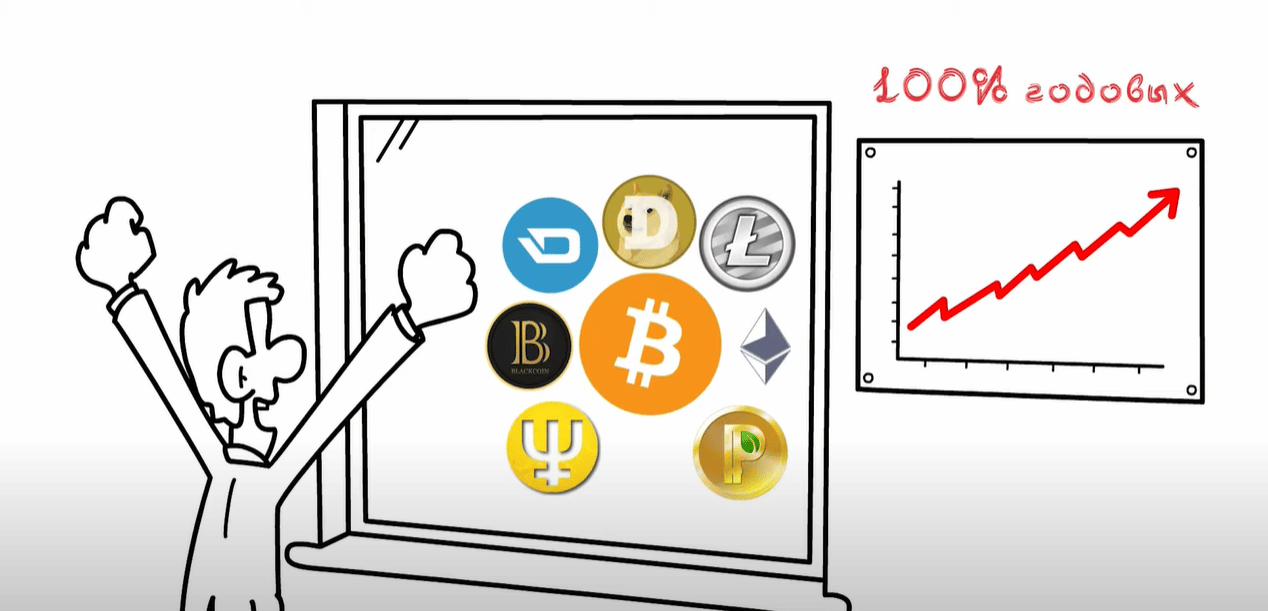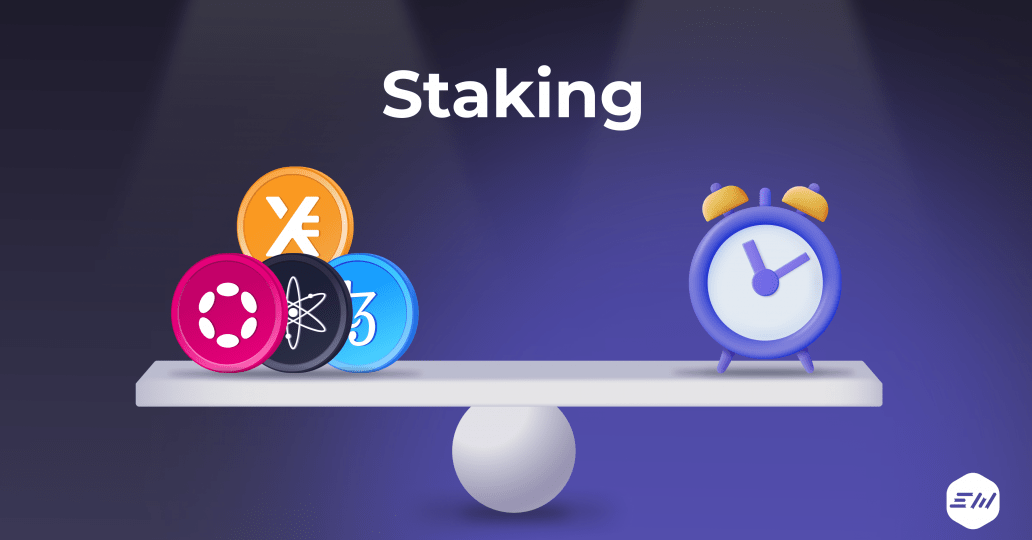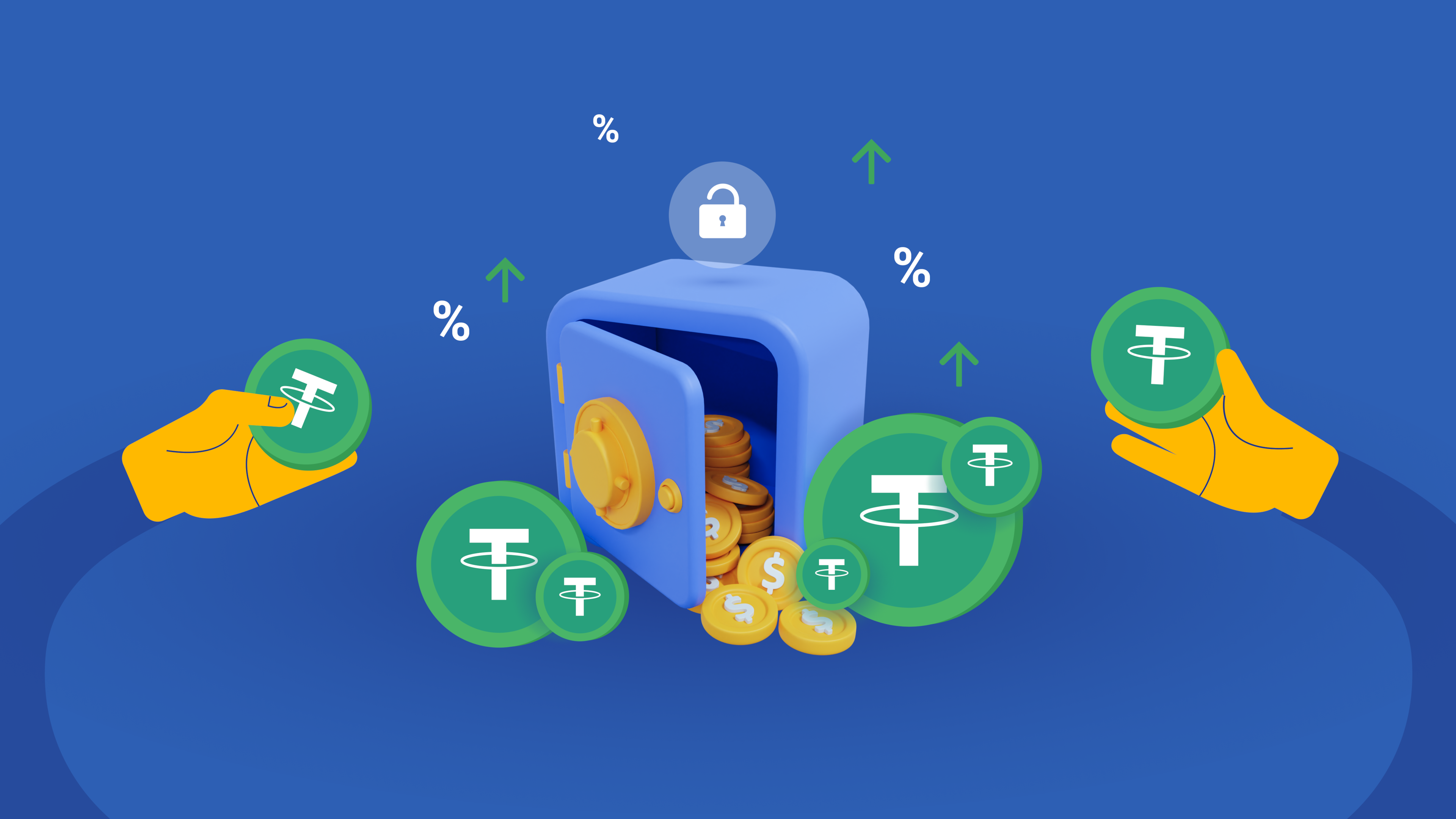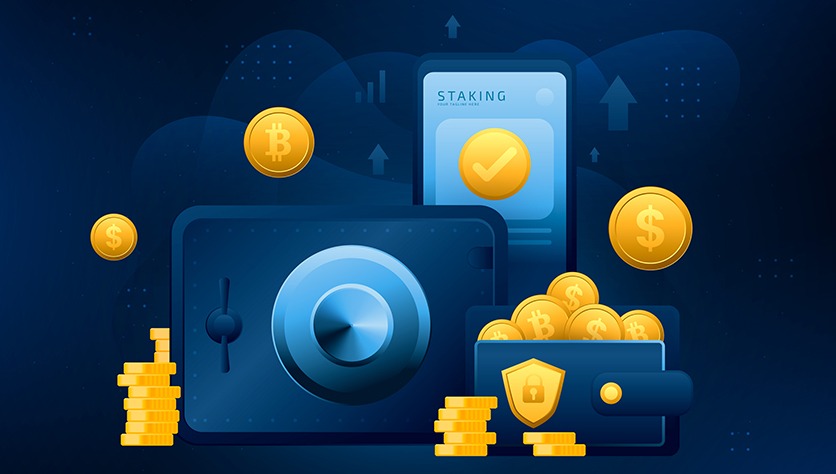Staking is a way to earn money in blockchain networks, where you “freeze” a certain amount of coins in your wallet to support the network. In return, you receive a reward in the form of additional coins. It is similar to putting money in a savings account at a bank and getting interest for it. In other words, it is a way to earn passive income simply by holding crypto coins. Imagine putting your coins in a deposit with interest, but instead of a bank, it is a blockchain network.

There is a fundamental difference between staking and mining. Mining is the process of creating new blocks in the blockchain using computing power. When staking, you “freeze” your coins for a period of time to ensure the security of the blockchain network and keep it running.
History of staking development
Staking emerged as part of the evolution of blockchain technology and cryptocurrencies. Here is a brief history of its development:
Birth of Proof of Stake (PoS)
In 2012, the first Proof of Stake (PoS) consensus mechanism was proposed in the Peercoin cryptocurrency. Unlike Proof of Work (PoW) used in Bitcoin, PoS allowed network participants to confirm transactions and create new blocks using their coins rather than their computing power.
Development of PoS algorithms
In the following years, new cryptocurrencies emerged that used improved versions of PoS, such as Nxt (2013) and BlackCoin (2014). These projects brought their own improvements and ideas, making staking more secure and efficient.
Popularization of staking
Since 2015, staking has grown in popularity due to the emergence of more well-known projects such as Ethereum, which began planning to transition from PoW to PoS via the Ethereum 2.0 upgrade. This has brought staking to the attention of the general public as a way to earn money from cryptocurrency.
Ethereum 2.0 and major projects
In December 2020, Ethereum launched the Beacon Chain, the first stage of its transition to PoS, which was a significant event for the entire crypto industry. This transition is expected to be one of the largest and most important for staking.
Staking concept
The staking concept is based on the Proof of Stake (PoS) consensus mechanism and its variations. This mechanism allows cryptocurrency owners to participate in the process of validating transactions and creating new blocks by freezing their coins in a special wallet. Here are the main aspects of the staking concept:

Basic principle: In PoS algorithms, the probability of a validator being selected to create the next block is proportional to the number of coins he «stakes» or freezes.
Network Security: Stakers are interested in the honest operation of the network, since in case of malicious actions their frozen coins can be partially or completely confiscated (penalty mechanism).
Reward: Validators are rewarded in the form of new coins or transaction fees. This incentivizes more people to participate in staking.
Passive Income: For users, staking is a way to earn passive income comparable to interest on a bank deposit.
Inflation: Some networks create staker rewards through inflation, i.e. the creation of new coins.
Commissions: In other networks, rewards may be generated from transaction fees.
Freezing Funds: Stakers are required to freeze their coins for a certain period of time during which they cannot use them.
Difficulty of setup: Participating in staking often requires technical literacy and an understanding of how wallets and blockchain networks work.
Pooling Resources: Users can join staking pools to collectively increase their chances of receiving rewards by sharing them proportionally to the coins they contribute.
Accessibility for all: Pools make staking accessible to users with smaller amounts of cryptocurrency.
Delegated Proof of Stake (DPoS): In this model, users delegate their coins to elected validators who are responsible for creating blocks.
Bonded Proof of Stake (BPoS): Here, validators must provide a certain amount of coins as collateral in order to participate in the validation process.
Overall, the concept of staking is aimed at increasing the security and efficiency of blockchain networks while providing users with the opportunity to earn income for participating in the network.
Cryptocurrencies for staking
Cryptocurrencies that use Proof-of-Stake (PoS) rely on the concept of staking to keep the network running instead of the traditional Proof-of-Work (PoW) which requires a lot of computing power. Here are some of the popular cryptocurrencies that work on PoS:

- Ethereum 2.0 (ETH) : Ethereum 2.0 switched from PoW to PoS, making the network more efficient and environmentally friendly. You can now stake coins to support the network.
- Cardano (ADA) : Cardano uses the Ouroboros consensus protocol (a variation of PoS) to achieve network scalability and security.
- Tezos (XTZ) : Tezos is another PoS-based blockchain aimed at building smart contracts and decentralized applications.
- Cosmos (ATOM) : Cosmos aims for interoperability between different blockchains and uses the Tendermint protocol with PoS.
- Polkadot (DOT) : Polkadot also aims for interoperability and uses the PoS consensus algorithm to ensure security and communication between different blockchains.
How Staking Works
To participate in staking, users freeze their coins for a certain period. These coins remain on their account but cannot be used for other transactions. Not all cryptocurrencies support staking. To begin with, a cryptocurrency is selected that uses the Proof of Stake (PoS) mechanism or its variations. Coin owners (stakers) store their coins in a special wallet that supports staking. Some cryptocurrency exchanges also offer staking services.

In PoS systems, the probability of being selected as a validator (the node that creates the next block) is proportional to the number of frozen coins. The more coins are frozen, the higher the chance of being selected as a validator. Validators verify transactions and create new blocks. This process requires significantly less computing resources compared to Proof of Work (PoW) used in Bitcoin. Validators receive a reward for their work. The reward may include new coins created by the blockchain and fees for transactions included in the block. In some systems, such as Delegated Proof of Stake (DPoS), users can delegate their coins to trusted validators who will perform validation functions on their behalf. Delegators receive a portion of the reward.

If a user does not have enough coins to participate in staking on their own, they can join a staking pool. In a pool, several users combine their coins, increasing their overall chances of receiving a reward, which is then distributed proportionally to the contribution made. After the freezing period, users can withdraw their coins and rewards. Some networks set a minimum freezing period after which funds can be withdrawn.
Staking thus works as a way to maintain the security and functionality of the blockchain by offering cryptocurrency holders a reward for their contribution. This helps decentralize the network and encourages active participation in its work.
Risks of Staking
Staking comes with certain risks and it is important to understand them before engaging in this activity.

Price volatility risk
Crypto assets are known for their high volatility. The value of frozen coins can drop significantly, leading to losses despite the rewards received.
Staking is a long-term investment and you must be prepared for market fluctuations.
Risk of asset freezing
When staking, you are required to lock your coins for a certain period of time. During this time, they are not available for sale or other transactions, which can be a problem when the market changes drastically. Depending on the project, this period can be long. If you suddenly need your funds, you will not be able to get them back until the lock is over.
Smart contract risk
Decentralized platforms use smart contracts for staking. Errors in the contract code can lead to loss of funds.
Before staking, make sure the platform is verified and secure.
Risk of insufficient liquidity

Some staking platforms or cryptocurrencies may have low liquidity, making it difficult to sell coins after the freeze period ends.
Counterparty risk
Trading in staking pools or using third-party platforms carries the risk of bad behavior on the part of the operators of these platforms, which may result in the loss of coins.
Some platforms may be scams. Research the platform and its reputation before staking.
Technical risks
Errors in the wallet software or network can lead to loss of coins. Hacking or other cyber attacks are also possible.
Risk of fines (slashing)
In some PoS systems, such as Ethereum 2.0, validators can be penalized for misbehavior or technical errors, such as prolonged downtime or violation of consensus rules. These penalties can result in the loss of some or all of the frozen coins.
The risk of centralization
In staking pools, large participants can gain disproportionate influence over the network, which is contrary to the idea of decentralization.
Inflation risk
In some cryptocurrencies, staker rewards are created through inflation, i.e. the creation of new coins. This can lead to the devaluation of existing coins.
Regulatory risks
Cryptocurrencies and related activities such as staking may be subject to regulatory changes in different countries. This may impact the legality and feasibility of staking.
Understanding these risks and conducting careful analysis before participating in staking will help minimize potential losses and make more informed investment decisions.
Types of staking

There are several types of staking.
Fixed staking
In this scheme, the user specifies a specific period for placing assets on their account. The token owner calculates a comfortable period during which the assets will be blocked and will bring a fixed profit at a pre-approved rate. Usually, long periods are chosen (quarter, half-year, year), and such contracts have a higher interest rate, which allows you to earn good money. The annual interest rate of different altcoins can reach 20%.
Perpetual staking
In this case, it is not necessary to block the coins for a fixed period, and they can be withdrawn from the block at any time. The interest is lower, but it is accrued until the participant decides to withdraw the tokens from the network or concludes a sale. The first income can be seen within 24 hours after sending the tokens to the block, but the payment is made monthly.
DeFi Staking
(alized finance) are blockchain-based services that operate through smart contracts. Users and companies can borrow coins at interest, locking them in the system to receive a reward.
How to start staking
Getting started with staking isn’t as difficult as it may seem. Here’s a step-by-step guide on how to do it:

- Choosing a cryptocurrency for staking :
- Explore various cryptocurrencies that support Proof of Stake (PoS) or its variations, such as Ethereum (after switching to PoS), Cardano, Polkadot, Tezos, and more.
- Choose a cryptocurrency based on its growth potential, risks, and your technical level.
- Buying cryptocurrency :
- Purchase your chosen cryptocurrency on a reliable cryptocurrency exchange. Make sure that the exchange supports the withdrawal of purchased coins to a wallet that allows staking.
- Choosing a wallet :
- Download and install the official wallet for your chosen cryptocurrency or use a supported third-party wallet.
- Make sure the wallet supports staking. Some popular staking wallets include Ledger, Trezor, Trust Wallet, and more.
- Transfer coins to wallet :
- Transfer your coins from the exchange to your wallet. Make sure you use the correct addresses and follow all instructions to avoid losing your coins.
- Setting up staking :
- In your wallet, find the staking option and follow the instructions to freeze your coins to participate in staking. The process may vary slightly depending on the cryptocurrency and wallet.
- In some systems, such as Tezos or Cardano, you may need to delegate your coins to a validator or delegate.
- Monitoring and management :
- Once you have set up staking, check your wallet and staking status regularly. Make sure your wallet is online and participating in the network.
- Keep an eye on your rewards and update your wallet software periodically to ensure security.
- Exiting staking (optional) :
- If you decide to stop staking, follow the instructions of your wallet or platform to unlock your coins. Please note that there may be a waiting period for unlocking.
- Accounting for tax implications :
- Depending on your jurisdiction, staking income may be subject to taxation. Research the tax regulations in your region and take this into account when planning your staking.
Alternative options

- Using Staking Platforms : Some cryptocurrency exchanges and platforms offer simplified staking solutions. For example, Binance , Kraken, Coinbase, and others provide staking services where you can simply hold your coins on the exchange and earn rewards.
- Staking Pools : If you don’t have enough coins to stake on your own, consider joining a staking pool, where multiple users pool their coins to increase their chances of winning rewards.
Getting started with staking is not difficult, but it is important to carefully research all aspects and risks in order to make an informed decision and maximize the income opportunities.
The Future of Staking
If we look at 2020 as the year of decentralized finance ( DeFi ), it’s worth noting the central role that crypto staking has played in the development of this new generation of crypto assets. The industry has seen a steady growth, and often a surge, in the number of users staking cryptocurrencies to earn a fixed percentage or to receive rewards for yield farming.
As more blockchains migrate from Proof of Work (PoW) to PoS, staking is becoming increasingly popular. Ethereum, one of the largest blockchain platforms, completed its transition to PoS with the Ethereum 2.0 update, attracting the attention and funds of a large number of investors.

DeFi projects continue to evolve and offer innovative staking solutions. DeFi platforms often offer high yields and flexible staking conditions, which attracts users who want to maximize their cryptocurrency income.
Large financial institutions are starting to show interest in staking, which could lead to increased staking volumes and stricter regulations. Institutional investors such as hedge funds and venture capitalists are already starting to invest in staking platforms and projects.
New technological developments and improvements in the blockchain field make staking more accessible and secure. Automation of staking processes and improvement of user experience contribute to the growing popularity of this method.
The development of the legal framework and regulation of the cryptocurrency market may influence the future of staking. The adoption of clear rules and standards can increase trust among users and attract new participants to the market.
The shift to PoS is also driven by environmental factors, as PoS requires significantly less energy compared to PoW. Given the growing concerns about climate change, many projects will be looking for greener solutions.
Potential integration of staking with traditional financial products such as bonds or deposit accounts could make staking more attractive to a wider audience, including those previously unfamiliar with cryptocurrencies.
Thus, cryptocurrency staking has every chance to become an even more significant and attractive component of the cryptocurrency market, offering users new opportunities to earn money and participate in blockchain ecosystems.
Автор Alex Smith
Имеет профессиональную подготовку в области микроэлектроники и аппаратного программирования, а также более 30-ти лет опыта работы с системами обработки и передачи данных, включая оборудование для майнинга криптовалют. Готовя материал для читателей блога BuyCrypt успешно применяет свой обширный технический бэкграунд для максимально точной передачи смысла материалов с используемых источников.




